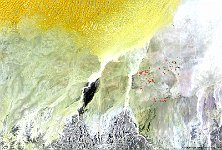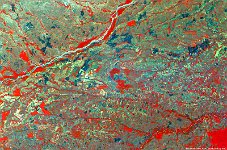 NEW NEW
06/03/2020, Las Gaviotas, Vichada, Colombia World Environment Day takes place every year on 5 June. It is the United Nations’ flagship day for promoting worldwide awareness and action for the environment, celebrated in more than 100 countries. Moreover, 2020 marks an important year for nations’ commitments to preserving and restoring biodiversity, with the UN Convention on Biological Diversity’s COP15, closing the UN Decade on Biodiversity and ramping up the Decade on Ecosystem Restoration (2021-2030). Colombia, host country of the World Environment Day, sustains close to 10 percent of the planet’s biodiversity in its Andean, Amazonian and humid Chocó region ecosystems. Thus, it is only fitting that PROBA-V takes a closer look at the Colombian Vichada department, between the Meta and Orinoco Rivers. Centred in the colourful image, we find a small eco-village, Las Gaviotas, creating a spot for sustainable living and eco-inventions, initially sponsored by the UN among others. Did you also know that … the UN’s recent report on the state of the worlds’ forests examines their contribution to the biodiversity targets and features the Copernicus Global Land Cover maps, derived from PROBA-V? |
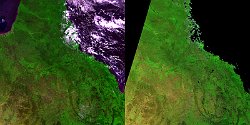
17/03/2020, West Australia With the operational lifetime of PROBA-V coming to an end on 30 June 2020, there are a number of ongoing efforts to ensure continuity of end-user products, such as Top-of-Canopy reflectance (TOC) and Normalized Difference Vegetation Index (NDVI), by switching from PROBA-V to Sentinel-3: 1. The SYN branch of the ESA Sentinel-3 processing provides 1 km VEGETATION-like products: TOA reflectance (SY_2_VGP), 1 day synthesis surface reflectance and NDVI (SY_2_VG1) and 10 day synthesis surface reflectance and NDVI (SY_2_V10). 2. The Copernicus Global Land Service is also preparing the switch for the 300 m and 1 km NDVI. The processing line will include BRDF-correction in order to minimize the effect of differences in illumination and viewing angles. We kindly ask our users to keep in mind that providing temporal consistency when switching from one sensor (PROBA-V) to another (Sentinel-3) is a challenge, because it is affected by many factors, such as differences in radiometric calibration, differences in spectral bands, and differences in orbital characteristics and scanning systems. All teams involved strive to minimize the impact to users and downstream services. |

13/09/2019, Ngorongoro Crater, Mount Kilimanjaro On 3 March, World Wildlife Day, established by the United Nations in 2013, is celebrated to raise awareness of the world’s wild animals and plants. The day has become the most important global annual event dedicated to wildlife. This year’s theme is "Sustaining all life on Earth", highlighting the importance of all wild animal and plant species as key components of the world's biodiversity. To honour this day, we share a beautiful 100 m image of the Ngorongoro Crater and Mount Kilimanjaro. The Ngorongoro Crater, a collapsed caldera volcano with a diameter of ~20 km at 2,200 m altitude, can be recognized as a circular shape in the image left-middle part. The crater is inhabited by a wealth of flora and fauna species and contains the highest concentration of wild animals, such as lions, gazelles, gnus, and rhinoceros. Mount Kilimanjaro, Africa’s highest mountain (5,895 m) is visible in dark brown in the right image part. The green colours surrounding the mountain indicate the various forest types on the mountain’s lower hills, which gradually changes into sparse vegetation (maquis) with increasing altitude. |
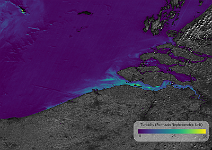
03/04/2016, TSM and Turbidity Turbidity is a measure of the clarity of water and an important parameter in environmental monitoring. High turbidity can be linked to a high amount of sediments suspended in water. These sediments prevent light reaching aquatic plants and organisms and can carry contaminants. The aquaculture sector, environmental agencies or dredging companies can all benefit and take actions based on turbidity measures. Although PROBA-V is a vegetation satellite designed to observe the land surface, the satellite covers coastal waters as well. The resolution and specifications of PROBA-V facilitate the generation of almost daily turbidity maps in coastal areas. This animation shows the combination of a PROBA-V image and a turbidity map of the Eastern part of the North Sea, near Belgium and the southern part of the Netherlands. The image was captured on 3rd of April 2016. You can see higher turbidity values in the Scheldt river and near the coastline around Zeebrugge. |
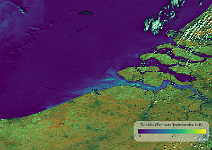
03/04/2016, TSM and Turbidity Turbidity is a measure of the clarity of water and an important parameter in environmental monitoring. High turbidity can be linked to a high amount of sediments suspended in water. These sediments prevent light reaching aquatic plants and organisms and can carry contaminants. The aquaculture sector, environmental agencies or dredging companies can all benefit and take actions based on turbidity measures. Although PROBA-V is a vegetation satellite designed to observe the land surface, the satellite covers coastal waters as well. The resolution and specifications of PROBA-V facilitate the generation of almost daily turbidity maps in coastal areas. This animation shows the combination of a PROBA-V image and a turbidity map of the Eastern part of the North Sea, near Belgium and the southern part of the Netherlands. The image was captured on 3rd of April 2016. You can see higher turbidity values in the Scheldt river and near the coastline around Zeebrugge. |
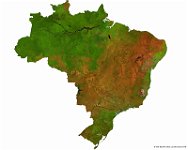
11/08/2017, Brazil, Overshoot Day Earth Overshoot Day is the day at which the world’s population’s resource consumption exceeds the natural Earth’s resources for a given year. The resource over-consumption was recorded first in the early 1970s. During the following decades, Overshoot Days gradually occurred earlier, from late December in the 1970s to 29 July this year. Additional to Earth Overshoot Day, a country’s Overshoot Day is the fictive Earth Overshoot Day if the entire world population would consume similar to a country’s population. These span a range from 11 February (Qatar) to 18 December (Indonesia). The image below shows a 10-day 300 m composite (11 – 20 August 2017) of Brazil, which has its Country Overshoot Day closest (31 July) to Earth Overshoot Day. The image shows among others the Amazon river basin and its vast tropical rain forest in dark green, with intermittent light brown patches indicating deforested areas. The extensive brown/reddish area in central and eastern Brazil indicates the Cerrado (tropical savanna) plateaus. |
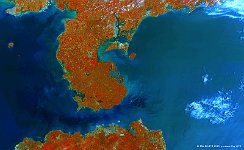
17/05/2019, Zhanjiang, China Today, 5 June, marks World Environment Day. This day was established in 1972 by the United Nations to raise people’s awareness on our vulnerable environment and the actual environmental issues. This year’s World Environment Day is hosted by China, with a theme on air pollution, a world-wide issue that is most prominent in the Asia-Pacific region. In this region, air pollution directly or indirectly causes an estimated 4 million deaths (from the 7 million people world-wide). In some major Chinese cities, the air can sometimes be so polluted that even on a ‘clear’ sunny day people hardly see the sun. Nevertheless, the Chinese government is taking measures to improve the air quality, which is already observed over the last few years from space by dedicated air quality satellite sensors. Below we show a PROBA-V image of 17 May 2019 of Zhanjiang, a city in the south of China with ~6.5 million inhabitants, located at the South Chinese Sea. The city can be seen as a grey area in the top-middle part of the image. At the bottom of the image the northern part of the Hainan island is visible. |

, Copernicus Climate Change Service In days of a heated climate change debate, objective, consistent, and quality-assured data and information about the various biospheres’ state is of vital importance. Such data will encourage our policy makers to take proper actions and stop global warming. Therefore the European Centre for Medium-Range Weather Forecasts (ECMWF) implemented the Copernicus Climate Change Service (C3S), one of the six thematic information services provided by the Copernicus Earth Observation Programme of the EU. In C3S, Climate Data Records (CDRs) of Essential Climate Variables (ECVs) using multiple satellite and in-situ data, as well as re-analyses of climate models and their projections, are generated. The C3S Land Biosphere component uses e.g. PROBA-V data to generate the longest possible, consistent, and mature satellite-based biosphere ECVs. An example of such a long-term consistent biosphere satellite data record is shown in the animation above. It presents for 2018 the monthly Leaf Area Index (LAI) anomaly (deviation) over Europe from the 1998 – 2017 average using harmonized SPOT-VGT and PROBA-V observations. It can be seen very well that due to the 2018 summer drought the vegetation’s leaves gradually dried out, resulting in lower LAI (indicated by the red areas) than the 1998 – 2017 average. |
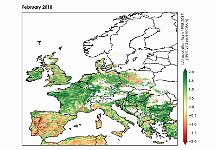
, Copernicus Climate Change Service In days of a heated climate change debate, objective, consistent, and quality-assured data and information about the various biospheres’ state is of vital importance. Such data will encourage our policy makers to take proper actions and stop global warming. Therefore the European Centre for Medium-Range Weather Forecasts (ECMWF) implemented the Copernicus Climate Change Service (C3S), one of the six thematic information services provided by the Copernicus Earth Observation Programme of the EU. In C3S, Climate Data Records (CDRs) of Essential Climate Variables (ECVs) using multiple satellite and in-situ data, as well as re-analyses of climate models and their projections, are generated. The C3S Land Biosphere component uses e.g. PROBA-V data to generate the longest possible, consistent, and mature satellite-based biosphere ECVs. An example of such a long-term consistent biosphere satellite data record is shown in the animation above. It presents for 2018 the monthly Leaf Area Index (LAI) anomaly (deviation) over Europe from the 1998 – 2017 average using harmonized SPOT-VGT and PROBA-V observations. It can be seen very well that due to the 2018 summer drought the vegetation’s leaves gradually dried out, resulting in lower LAI (indicated by the red areas) than the 1998 – 2017 average. |
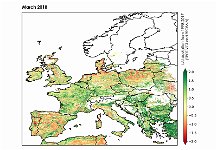
, Copernicus Climate Change Service In days of a heated climate change debate, objective, consistent, and quality-assured data and information about the various biospheres’ state is of vital importance. Such data will encourage our policy makers to take proper actions and stop global warming. Therefore the European Centre for Medium-Range Weather Forecasts (ECMWF) implemented the Copernicus Climate Change Service (C3S), one of the six thematic information services provided by the Copernicus Earth Observation Programme of the EU. In C3S, Climate Data Records (CDRs) of Essential Climate Variables (ECVs) using multiple satellite and in-situ data, as well as re-analyses of climate models and their projections, are generated. The C3S Land Biosphere component uses e.g. PROBA-V data to generate the longest possible, consistent, and mature satellite-based biosphere ECVs. An example of such a long-term consistent biosphere satellite data record is shown in the animation above. It presents for 2018 the monthly Leaf Area Index (LAI) anomaly (deviation) over Europe from the 1998 – 2017 average using harmonized SPOT-VGT and PROBA-V observations. It can be seen very well that due to the 2018 summer drought the vegetation’s leaves gradually dried out, resulting in lower LAI (indicated by the red areas) than the 1998 – 2017 average. |
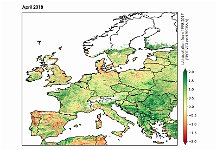
, Copernicus Climate Change Service In days of a heated climate change debate, objective, consistent, and quality-assured data and information about the various biospheres’ state is of vital importance. Such data will encourage our policy makers to take proper actions and stop global warming. Therefore the European Centre for Medium-Range Weather Forecasts (ECMWF) implemented the Copernicus Climate Change Service (C3S), one of the six thematic information services provided by the Copernicus Earth Observation Programme of the EU. In C3S, Climate Data Records (CDRs) of Essential Climate Variables (ECVs) using multiple satellite and in-situ data, as well as re-analyses of climate models and their projections, are generated. The C3S Land Biosphere component uses e.g. PROBA-V data to generate the longest possible, consistent, and mature satellite-based biosphere ECVs. An example of such a long-term consistent biosphere satellite data record is shown in the animation above. It presents for 2018 the monthly Leaf Area Index (LAI) anomaly (deviation) over Europe from the 1998 – 2017 average using harmonized SPOT-VGT and PROBA-V observations. It can be seen very well that due to the 2018 summer drought the vegetation’s leaves gradually dried out, resulting in lower LAI (indicated by the red areas) than the 1998 – 2017 average. |

, Copernicus Climate Change Service In days of a heated climate change debate, objective, consistent, and quality-assured data and information about the various biospheres’ state is of vital importance. Such data will encourage our policy makers to take proper actions and stop global warming. Therefore the European Centre for Medium-Range Weather Forecasts (ECMWF) implemented the Copernicus Climate Change Service (C3S), one of the six thematic information services provided by the Copernicus Earth Observation Programme of the EU. In C3S, Climate Data Records (CDRs) of Essential Climate Variables (ECVs) using multiple satellite and in-situ data, as well as re-analyses of climate models and their projections, are generated. The C3S Land Biosphere component uses e.g. PROBA-V data to generate the longest possible, consistent, and mature satellite-based biosphere ECVs. An example of such a long-term consistent biosphere satellite data record is shown in the animation above. It presents for 2018 the monthly Leaf Area Index (LAI) anomaly (deviation) over Europe from the 1998 – 2017 average using harmonized SPOT-VGT and PROBA-V observations. It can be seen very well that due to the 2018 summer drought the vegetation’s leaves gradually dried out, resulting in lower LAI (indicated by the red areas) than the 1998 – 2017 average. |
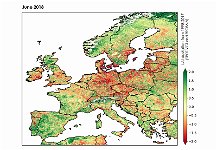
, Copernicus Climate Change Service In days of a heated climate change debate, objective, consistent, and quality-assured data and information about the various biospheres’ state is of vital importance. Such data will encourage our policy makers to take proper actions and stop global warming. Therefore the European Centre for Medium-Range Weather Forecasts (ECMWF) implemented the Copernicus Climate Change Service (C3S), one of the six thematic information services provided by the Copernicus Earth Observation Programme of the EU. In C3S, Climate Data Records (CDRs) of Essential Climate Variables (ECVs) using multiple satellite and in-situ data, as well as re-analyses of climate models and their projections, are generated. The C3S Land Biosphere component uses e.g. PROBA-V data to generate the longest possible, consistent, and mature satellite-based biosphere ECVs. An example of such a long-term consistent biosphere satellite data record is shown in the animation above. It presents for 2018 the monthly Leaf Area Index (LAI) anomaly (deviation) over Europe from the 1998 – 2017 average using harmonized SPOT-VGT and PROBA-V observations. It can be seen very well that due to the 2018 summer drought the vegetation’s leaves gradually dried out, resulting in lower LAI (indicated by the red areas) than the 1998 – 2017 average. |
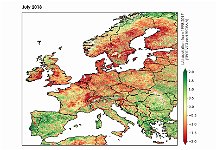
, Copernicus Climate Change Service In days of a heated climate change debate, objective, consistent, and quality-assured data and information about the various biospheres’ state is of vital importance. Such data will encourage our policy makers to take proper actions and stop global warming. Therefore the European Centre for Medium-Range Weather Forecasts (ECMWF) implemented the Copernicus Climate Change Service (C3S), one of the six thematic information services provided by the Copernicus Earth Observation Programme of the EU. In C3S, Climate Data Records (CDRs) of Essential Climate Variables (ECVs) using multiple satellite and in-situ data, as well as re-analyses of climate models and their projections, are generated. The C3S Land Biosphere component uses e.g. PROBA-V data to generate the longest possible, consistent, and mature satellite-based biosphere ECVs. An example of such a long-term consistent biosphere satellite data record is shown in the animation above. It presents for 2018 the monthly Leaf Area Index (LAI) anomaly (deviation) over Europe from the 1998 – 2017 average using harmonized SPOT-VGT and PROBA-V observations. It can be seen very well that due to the 2018 summer drought the vegetation’s leaves gradually dried out, resulting in lower LAI (indicated by the red areas) than the 1998 – 2017 average. |
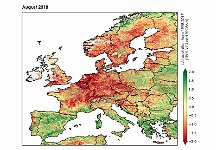
, Copernicus Climate Change Service In days of a heated climate change debate, objective, consistent, and quality-assured data and information about the various biospheres’ state is of vital importance. Such data will encourage our policy makers to take proper actions and stop global warming. Therefore the European Centre for Medium-Range Weather Forecasts (ECMWF) implemented the Copernicus Climate Change Service (C3S), one of the six thematic information services provided by the Copernicus Earth Observation Programme of the EU. In C3S, Climate Data Records (CDRs) of Essential Climate Variables (ECVs) using multiple satellite and in-situ data, as well as re-analyses of climate models and their projections, are generated. The C3S Land Biosphere component uses e.g. PROBA-V data to generate the longest possible, consistent, and mature satellite-based biosphere ECVs. An example of such a long-term consistent biosphere satellite data record is shown in the animation above. It presents for 2018 the monthly Leaf Area Index (LAI) anomaly (deviation) over Europe from the 1998 – 2017 average using harmonized SPOT-VGT and PROBA-V observations. It can be seen very well that due to the 2018 summer drought the vegetation’s leaves gradually dried out, resulting in lower LAI (indicated by the red areas) than the 1998 – 2017 average. |
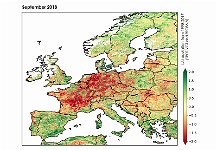
, Copernicus Climate Change Service In days of a heated climate change debate, objective, consistent, and quality-assured data and information about the various biospheres’ state is of vital importance. Such data will encourage our policy makers to take proper actions and stop global warming. Therefore the European Centre for Medium-Range Weather Forecasts (ECMWF) implemented the Copernicus Climate Change Service (C3S), one of the six thematic information services provided by the Copernicus Earth Observation Programme of the EU. In C3S, Climate Data Records (CDRs) of Essential Climate Variables (ECVs) using multiple satellite and in-situ data, as well as re-analyses of climate models and their projections, are generated. The C3S Land Biosphere component uses e.g. PROBA-V data to generate the longest possible, consistent, and mature satellite-based biosphere ECVs. An example of such a long-term consistent biosphere satellite data record is shown in the animation above. It presents for 2018 the monthly Leaf Area Index (LAI) anomaly (deviation) over Europe from the 1998 – 2017 average using harmonized SPOT-VGT and PROBA-V observations. It can be seen very well that due to the 2018 summer drought the vegetation’s leaves gradually dried out, resulting in lower LAI (indicated by the red areas) than the 1998 – 2017 average. |

, Copernicus Climate Change Service In days of a heated climate change debate, objective, consistent, and quality-assured data and information about the various biospheres’ state is of vital importance. Such data will encourage our policy makers to take proper actions and stop global warming. Therefore the European Centre for Medium-Range Weather Forecasts (ECMWF) implemented the Copernicus Climate Change Service (C3S), one of the six thematic information services provided by the Copernicus Earth Observation Programme of the EU. In C3S, Climate Data Records (CDRs) of Essential Climate Variables (ECVs) using multiple satellite and in-situ data, as well as re-analyses of climate models and their projections, are generated. The C3S Land Biosphere component uses e.g. PROBA-V data to generate the longest possible, consistent, and mature satellite-based biosphere ECVs. An example of such a long-term consistent biosphere satellite data record is shown in the animation above. It presents for 2018 the monthly Leaf Area Index (LAI) anomaly (deviation) over Europe from the 1998 – 2017 average using harmonized SPOT-VGT and PROBA-V observations. It can be seen very well that due to the 2018 summer drought the vegetation’s leaves gradually dried out, resulting in lower LAI (indicated by the red areas) than the 1998 – 2017 average. |
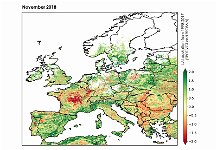
, Copernicus Climate Change Service In days of a heated climate change debate, objective, consistent, and quality-assured data and information about the various biospheres’ state is of vital importance. Such data will encourage our policy makers to take proper actions and stop global warming. Therefore the European Centre for Medium-Range Weather Forecasts (ECMWF) implemented the Copernicus Climate Change Service (C3S), one of the six thematic information services provided by the Copernicus Earth Observation Programme of the EU. In C3S, Climate Data Records (CDRs) of Essential Climate Variables (ECVs) using multiple satellite and in-situ data, as well as re-analyses of climate models and their projections, are generated. The C3S Land Biosphere component uses e.g. PROBA-V data to generate the longest possible, consistent, and mature satellite-based biosphere ECVs. An example of such a long-term consistent biosphere satellite data record is shown in the animation above. It presents for 2018 the monthly Leaf Area Index (LAI) anomaly (deviation) over Europe from the 1998 – 2017 average using harmonized SPOT-VGT and PROBA-V observations. It can be seen very well that due to the 2018 summer drought the vegetation’s leaves gradually dried out, resulting in lower LAI (indicated by the red areas) than the 1998 – 2017 average. |
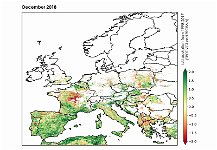
, Copernicus Climate Change Service In days of a heated climate change debate, objective, consistent, and quality-assured data and information about the various biospheres’ state is of vital importance. Such data will encourage our policy makers to take proper actions and stop global warming. Therefore the European Centre for Medium-Range Weather Forecasts (ECMWF) implemented the Copernicus Climate Change Service (C3S), one of the six thematic information services provided by the Copernicus Earth Observation Programme of the EU. In C3S, Climate Data Records (CDRs) of Essential Climate Variables (ECVs) using multiple satellite and in-situ data, as well as re-analyses of climate models and their projections, are generated. The C3S Land Biosphere component uses e.g. PROBA-V data to generate the longest possible, consistent, and mature satellite-based biosphere ECVs. An example of such a long-term consistent biosphere satellite data record is shown in the animation above. It presents for 2018 the monthly Leaf Area Index (LAI) anomaly (deviation) over Europe from the 1998 – 2017 average using harmonized SPOT-VGT and PROBA-V observations. It can be seen very well that due to the 2018 summer drought the vegetation’s leaves gradually dried out, resulting in lower LAI (indicated by the red areas) than the 1998 – 2017 average. |
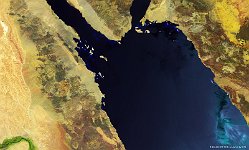
18/04/2018, Red Sea World Wildlife Day, on March 3rd, reminds us of the signing of the Convention on International Trade in Endangered Species (CITES). It has become the most important global, annual event dedicated to the conservation of wildlife. This year, the event focuses on UN SDG 14 – the sustainable use of our planet’s oceans, seas and marine resources. The Red Sea is a rich and diverse ecosystem, supporting over 1200 species of fish, in part due to the 2000 kilometers of coral reefs along its coast. It features on the WWF’s Global 200 list of priority ecoregions for conservation. This 100 m image of the northern half of the Red Sea, highlights nicely the coral reefs along the coast of the Saudi region Tabuk (east). The wildlife and reefs make for attractive diving spots for tourists, like those visiting Ras Mohammad, the marine national park nearby Sharm El Sheikh, at the tip of the Sinai peninsula (north). |
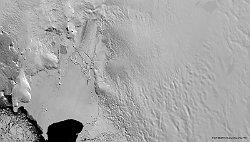
19/11/2018, Pine Island's Iceberg The Pine Island Glacier is one of Antarctica’s largest ice streams, located south of the Hudson Mountains on West-Antarctica. It drains 5 – 10% of West-Antarctica’s ice sheets and is the continent’s fastest melting glacier. Since the 1990s, the glacier has thinned by about 1.5 meters per year and its flow into the sea has increased. Recently, as for the previous years, a large iceberg with an area of ~300 km2 calved off the glacier. As PROBA-V observes Antarctica during the austral summer, it was able to capture this calving. The 300 m image of 19 November 2018 shows the iceberg a couple of weeks after it calved off from the Pine Island Glacier. PROBA-V will observe Antarctica till the end of February 2019. All observations (November 2018 - February 2019) are made available through the data portal and the Mission Exploitation Platform (MEP) so users can play around with the data using all available tools. |
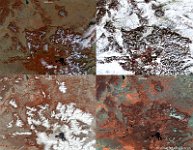
2016-2017, Yellowstone, Wyoming The Yellowstone National Park is the world’s oldest (established in 1872) ... and has an area of nearly 9,000 km2. The park’s area is geologically active and contains about half of the world’s geysers and hydrothermal features. The Yellowstone Lake is located at 2,350 m altitude over a supercaldera (~70 km diameter) that could emit about 2,500 km3 of ash when erupting. Yellowstone’s climate is significantly influenced by the Snake River Plain, a geological feature that formed over millions of years when the North-American tectonic plate moved over the Yellowstone hotspot. This eventually resulted in a 100 km wide channel from the Pacific Ocean into Yellowstone Park, enabling a dominant maritime airflow into the park and adjacent areas. This leads to annual precipitation amounts of up to 2,000 mm in the park’s western part, with abundant snow during November – April, as is visible from the images covering the four seasons from autumn (upper left) through summer (lower right). |
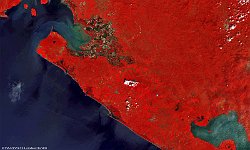
21/11/2017, Nicaragua Each year, the Food and Agriculture Organization of the United Nations (FAO) celebrates World Food Day on 16 October, to commemorate its founding in 1945. On this day, a large number of events promote awareness and call to action to ensure food security worldwide, with a strong message: hunger can be ended in this lifetime. Let’s work together to become the Zero Hunger Generation! Within FAO’s Global Information and Early Warning System (GIEWS), a specific system for global drought monitoring was addd: the Agricultural Stress Index System (ASIS). For ASIS, VITO automatically processes Remote Sensing data to produce maps on the extent, duration and severity of drought events every 10 days, like the example for Nicaragua above. Information on the historical probability of drought is provided as well. Such information is found particularly useful to guide public investments, for instance in the establishment of irrigation systems. Discover more in the ASIS blog post 'ASIS, the tool for agricultural drought monitoring' published to help raise awareness for World Food Day 2018! |
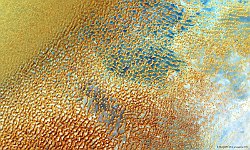
, Guess the location and win! Every day, PROBA-V monitors our Earth surface from space. Every week, we share a glimpse of a place on Earth, as seen through PROBA-V’s eyes, some 800 kilometres up in the sky. Take this colourful image for example… it’s almost like a piece of art. But what if we don't tell you what the image is showing…can you guess the location? A single winner will be rewarded with a PROBA-V goodie bag and will of course be credited in one of our upcoming Image of the Week mailings. We're looking forward to receiving your answers. Good luck! |
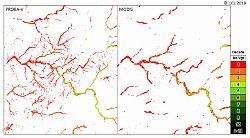
, Desert Locust Swarms of the Desert Locust can grow to several hundred square kilometres in size. The 40 to 80 million adult locusts in each square kilometre of the swarm can eat up the same amount of food in one day as roughly 35 000 people. Combined with its ability to migrate over large distances, this makes the Desert Locust a threat to food security in many countries in and around the Sahara and the deserts of the Middle East and South-West Asia. To help monitor and control the locusts, the United Nations Food and Agriculture Organization (FAO) operates a central information service, called Locust Watch, and gives out timely warnings, forecasts, training and support to the staff of locust control centres in the affected countries. In a pilot on the MEP platform and supporting FAO’s efforts, UCL extended an algorithm used to produce dynamic greenness maps to use PROBA-V 100 m input data instead of MODIS. These maps highlight areas in need of locust surveying. Click here to discover more on how PROBA-V MEP allowed UCL to apply the processing chain on PROBA-V 100 m time series and provide Dynamic Greenness Maps at a much finer scale to FAO. |
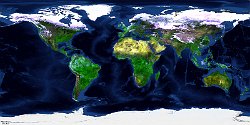
01/04/1998, SPOT-VEGETATION 20 years The SPOT-4 spacecraft was launched on March 24, 1998, just over 20 years ago. It included the first VEGETATION instrument (VGT-1) with four optical bands to monitor global vegetation at 1km spatial resolution. The ground segment preparations started one year earlier and provided the starting point for VITO’s operational processing and delivery of Earth Observation satellite data, as part of a joint programme of the European Commission, France, Belgium, Sweden and Italy. This week’s image celebrates this anniversary, by taking us back to the very first global, 10-daily synthesis (S10) of 1-10 April 1998. With SPOT5-VGT2 (since 2003) and PROBA-V (since May 2013), the time series of vegetation data is continuing. It has been an interesting journey indeed: from a small team, with just a few computers and less than 1TB of data, up to today’s data centre with 5PB storage, on-demand and cloud processing, used for multi-mission data processing. These capabilities were used in over 15 years of R&D projects, and are still used in operational services, like those for the European flagship programme Copernicus, still called GMES when it was established back in…1998. |
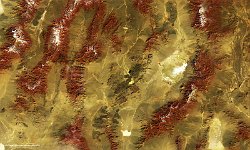
04/02/2018, Nevada, USA In the face of limitations in revisit times and frequent cloud coverage, many land and water applications need to combine data from multiple medium or high resolution sensors in order to build a time series. In Dec 2017, the BELHARMONY research project started off with the aim to assess the consistency between recent, high resolution Earth Observation sensors, focusing on PROBA-V (100m), Sentinel-2 and Landsat-8 and DEIMOS-1. It addresses for instance biases between the sensors at early processing stages (level-1, top-of-atmosphere) using a series of calibration sites. An example is the dry lakebed of the Railroad Valley Playa calibration site in Nevada, USA, shown in this week’s 100m PROBA-V image. In addition, BELHARMONY looks into the differences in the relative spectral response (for level-2 reflectance products) and the use of a common processing chain towards a set of derived land and water parameters (level-3 processing). To evaluate the impact of the harmonization measures, the project relies on EO and in situ data collection over the network of urban, agricultural and coastal sites from the Belgian BELAIR network. |
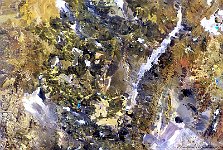
05/04/2017, Atacama, Chile and Catamarca, Argentina In the Southern Volcanic Zone of the Andes, on the border of Chile and Argentina, at altitudes ranging between 3 and 6.5 kilometers above sea level, PROBA-V spotted a lovely patchwork of volcanic fields, with several calderas and lava flows (black), alternating with salt deserts and salt lagunes (white) in this false-colour, 100 m image from April last year. Prominently visible is the elongated and narrow salt desert of Antofalla, the longest in the world. It is accompanied by the Namesake volcano (6,400 m) to its northwest. In the northwest corner is the Lago Salar del Hombre Muerto (salt lake of the dead man), a name that testifies to the harsh, dry and cold environment of this remote area, used mainly for tourism and scientific expeditions. Despite the aridity (less than 200 mm precipitation annually), there are some green pastures and small lakes (Lagunas), shown here in bright blue that support for instance Andean wildlife such as flamingos, foxes or vicuñas. |
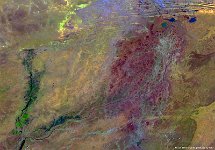
29/06/2016, Dioura, Mali Did you see VITO’s recent blog on how an international NGO like Action Contre La Faim (Action Against Hunger) uses Earth Observation data to support the pastoralists (cattle herders) in the Sahel of western Africa? The EO data they use is derived from SPOT/VGT and PROBA-V, in the context of a long-standing bilateral partnership ACF-VITO and the Copernicus Global Land Service. It’s a clear example of a collaboration that can make a real difference on the ground, by feeding into a web-GIS portal that shows the latest maps on water resource availability and biomass production anomalies (like the examples above). These maps and data are also shared with other humanitarian aid workers and used as input for Mali’s national early warning system. |
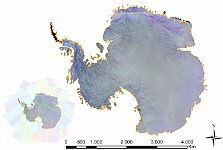
11/2017, Antarctica As many of you showed interest in Antarctica, it was decided to acquire PROBA-V images over this continent from November 2017 up to February 2018. These 1 km, 300 m and 100 m products will be processed up to L2A and provided in a polar stereographic projection. They will be made available to you via the regular portal as well as the PROBA-V Mission Exploitation Platform (https://proba-v-mep.esa.int/), from January 2018 onwards. A second announcement will be made when these products are available for download. In the image on the left, you can see the orbits needed to image the total land mass of Antarctica in 1 km or 300 m resolution. The image on the right shows the result of a seamless mosaic of these orbits, projected and cropped to the land borders. |
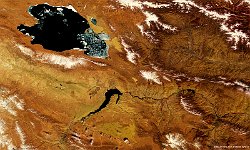
01/04/2017, Gonghe Power Plant, China In this 100 m image from April this year, PROBA-V spotted the Longyangxia solar-hydro power station, just to the west of the Longyangxia Reservoir in China’s Qinghai province. This station, covering an impressive 23 square kilometres, has become one of the most productive in the world, yielding around 850MW in solar and almost 1300MW in hydroelectric power. Moreover, the joint regulation of the solar park and the dam’s turbines balance the output from the variable solar power generation and helps to conserve water. The picture also captured Qinghai Lake, the largest lake in China, located in a hollow of the Tibetan Plateau at at 3200 m above sea level. No deeper than 30 meters and declining in depth, it’s still a major water source for many. The lake shrunk in surface area in most of the 20th century, but its size is recovering since 2004. |
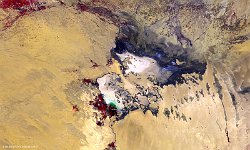
12/09/2017, Chott Melghir, Algeria The 100 m false-colour PROBA-V image of 12 September 2017 shows us a mix of wadi, agriculture patterns, alluvial fans, around Chott Melghir (upper center) and Chott Felrhir (lower center), 2 endorheic salt lakes in northeastern Algeria. It lies almost entirely below the sea level and contains the lowest point in Algeria, −40 meters. The shallow waters of the lake contain scarce vegetation composed of 72 species of plants which have adapted to salty water, such as Parish's glasswort, sea lavender, rushes, glasswort, etc. Some species are unique for Algeria and 14 are endemic. |
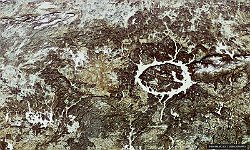
23/01/2017, Manicouagan crater, Quebec The 100 m false-colour image of 16 july 2016 shows us Lake Manicouagan, a ring-like lake in central Quebec, Canada. It shows the huge, almost perfect circle that scientists believe resulted from the impact of a giant meteorite, 200 million years ago. The collision melted the rock and pressure created the central mound. The crater is a multiple-ring structure about 100 km across, with the reservoir at its 70 km diameter inner ring being its most prominent feature. It surrounds an inner island plateau called René-Levasseur Island. The lake and island are clearly seen from space and are sometimes called the "eye of Quebec." |
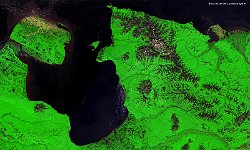
11/08/2017, Chaunskaya Bay, Russia The 100 m false-colour image of 11 August 2017 shows us Chaunskaya Bay, the largest bay of the East-Siberian Sea, Russia. The large island in the west is called Ayon. Pevek is a port town located just southeast of the two small islands east of Ayon. Apparently Pevek is the northern-most town in Asia. The two islands are Bolshoy Routan Island (larger) and Malyy Routan Island (smaller one). Ayon is inhabited by the Chukchi people. The Chukchi are indigenous to the area and many still practice a semi-nomadic lifestyle, hunting marine wildlife and herding reindeer. The island, peninsula and delta is peppered by lakes and is clearly a wetland habitat with many rivers draining into the bay especially the Chaun river. Chaunskaya Guba is a natural reserve or zakaznik in Russian. Eight species of whale have been reported here with only 3 common species: Beluga, Gray and Bowhead whale. Walrus and four species of seal are reported from here while the Polar Bear is common. Several Eider species migrate from the east into the Bay during the Spring. The bay itself is dominated by Bivalves. Ayon is also a seabird colony with nearly 10,000 individuals. The wetlands are rich in plant communities typically known as salt marsh vegetation. It consists of sedges, grasses, herbs of the families: Cyperaceae, Pooaceae and Rosaceae typically native to the Arctic. Notice the distinct spectral light brown of North Ayon island indicative of a Poacea dominant habitat. The hills inland of Pevek are part of the Chukotsky range and are composed of granite dated to 100 million years ago. These are dark brown in colour sitting above the green mat of vegetation. These hills can be seen around Pevek as well. Chintan Sheth from India is the winner of our 4th PROBA-V Quiz! Congratulations! |
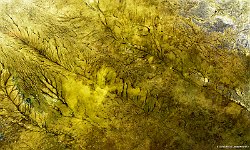
15/04/2017, Daror, Ethiopia On the 1400 to 1600 m high plateau of the Somali region in southeast Ethiopia, often called Ogaden, PROBA-V finds the town of Daror in this colourful 100 m image taken in mid April, 2017. This town is on a significant route for cattle trade in the Haud, an area with typical thorn-bush and grasslands used by traditional Somali herdsmen. Along with the more populated, nearby districts (woredas) in the Somali region, and neighbouring parts parts of Kenya (to the southwest) and Somalia (to the east), this area in the Horn of Africa is regularly hit by drought, often driven by El Niño climatic events. With cumulative rains between June 2016 and June 2017 reaching the first or second lowest level in 36 years, the prolonged drought drove a major food security emergency and marked the areas as priority for international food aid, disaster relief efforts and health workers. |
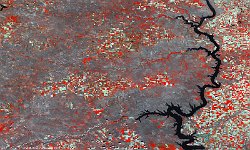
03/06/2017, Standing Rock Indian Reservation, USA At 9 August, the UN “International Day of the World’s Indigenous Peoples” is celebrated to pay attention to the survival, dignity, and well-being of indigenous peoples. This year’s theme is dedicated to the 10th anniversary of this day. The American Indians are probably the most well-known Indigenous Peoples. Dispossessed from their land and relocated to dedicated areas remote from European-populated areas during the 19th century, the United States Government created dedicated reservations for the American Indians from the 1880s onwards. The Standing Rock Indian Reservation is one of seven reservations (established in 1889) created for Sioux Indians, covering an area of nearly 9,300 km2 in North and South Dakota. Last year, large protests against the construction of the Dakota Access Pipeline through the Reservation area drew international attention. The false-colour 100 m image of 3 June 2017 shows the Standing Rock Indian Reservation area, with a remarkable alternation of red and grey appearing patches, which indicate cultivated and bare soils, respectively. At the right part of the image, the Missouri River is visible, flowing southward towards Saint Louis to merge with the Mississippi River. |
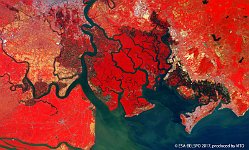
21/02/2016, Mangrove, Vietnam In November 2015, UNESCO proclaimed July 26 as the International Day for the Conservation of the Mangrove Ecosystem, thereby underlined the importance of the unique but vulnerable mangrove ecosystems around the world. Mangroves provide substantial benefits, by improving food security, protecting against storms or shoreline erosion, providing habitats of rare wildlife species and sequestering and storing blue carbon important for mitigating climate change. To this occasion, PROBA-V visits the Can Gio mangrove forest and biosphere reserve in Vietnam, ~40 km southeast of Ho Chi Min city that is visible in grey tones at the top of the image. The myriad of waterways through the mangrove forest (dark red, centre) and agricultural fields (dark tones on the banks) are particularly striking. This is put in contrast to the city’s growth in population, which has nearly doubled to 8.5 million over the last 20 years. |

07/05/2017, Everglades, Florida Multitemp is the bi-annual conference that aims to advance the knowledge on the use of Earth Observation time series, such as the historical records provided by SPOT-VEGETATION and PROBA-V. The Belgian Science Policy Office (BELSPO) and VITO are proud to be the local organizer of Multitemp 2017, to take place in Bruges, Belgium this week (27-29 June). By focussing on methodological improvements, Multitemp welcomes and encourages the cross-fertilization between application domains like climate, biodiversity and ecosystems, forestry, water and coastal management. Those application domains are particularly relevant in the protection of the extensive wilderness of the Florida Everglades, displayed in this PROBA-V image from early May 2017. The southern 20% of the original Everglades are a national park and one of only three locations in the world that are recognized, simultaneously, as International Biosphere Reserve, World Heritage Site (UNESCO) and Wetland of International Importance (RAMSAR). |

25/07/2014, Craters of the Moon, Idaho In southern Idaho and to the southwest of Yellowstone National Park, PROBA-V spotted the Craters of the Moon, a United States monument and nature preserve. In the false-colour image, the preserve is shown prominently in dark brown, surrounded by agricultural fields in scattered red. Formed over thousands of years by lava eruptions along the Great Rift, with the most recent one occurring 2000 years ago, Craters of the Moon provides a unique landscape with a mixture of lava flows, cinder cones and sagebrush. The geology of the area, resembling the volcanic surface of the Moon, has inspired trainers and educators for many years. Not in the least from NASA, when it trained the Apollo astrounauts to walk on the natural satellite and compagnon of our Blue Planet in the 1960s. |
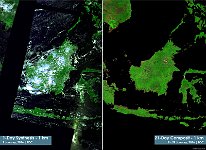
01/2016, Indonesia-Philippines Several parts of the world, among which the equatorial region, are frequently cloud-covered. In order to facilitate proper land surface research, the PROBA-V Mission Exploitation Platform (MEP) provides the possibility to compose synthesis images for various time periods. As an example, the left image shows the 1-day synthesis over parts of Indonesia and the Philippines on 9 January 2016, while the right image shows a nearly cloud-free 21-day composit over the same area for 9 - 29 January 2016. |
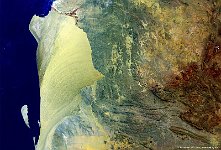
10/05/2016, Parque Nacional, Angola This image shows us Iona National Park, a national park in Namibia province of Angola. It is about 200 km from the city of Namibe and with 15,000 square kilometers, the largest in the country. The park is also known for unique flora and incredible rock formations. Iona is the oldest and largest national park in Angola. |
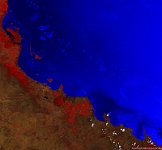
06/01/2016, Great Barrier Reef, Australia This image shows us Great Barrier Reef’s northern part, recognisable by the light-blue taints, while deeper parts of the Pacific Ocean appear dark-blue. The Great Barrier Reef is the world's largest coral reef system composed of over 2,900 individual reefs and 900 islands stretching for over 2,300 kilometres over an area of approximately 344,400 square kilometres. The reef is located in the Coral Sea, off the coast of Queensland, Australia. The Great Barrier Reef can be seen from outer space and is the world's biggest single structure made by living organisms. |
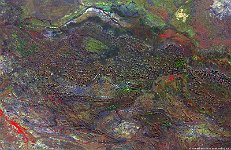
29/06/2015, Hamersley Range, Australia The 100 m false-colour image of 29 June 2015 shows us Hamersley Range, a mountainous region of the Pilbara, Western Australia. Karijini National Park one of Australia's largest National Parks, centred in the image. |
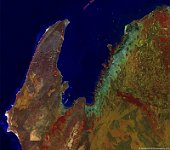
24/06/2015, Exmouth Gulf, Australia The 100 m false-colour image of 24 June 2015 shows us Exmouth Gulf, in the north-west of Western Australia. Exmouth Gulf is a rich marine environment. It is a nursery for humpback whales, dugong and turtles. The mangrove systems on the eastern margins are areas of high primary productivity feeding and restocking both the Gulf and the famed nearby Ningaloo Reef. The Gulf sustains one of Western Australia's largest prawn fisheries. |
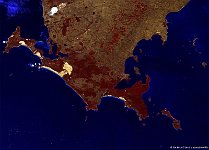
03/04/2015, Eyre Peninsula, Australia The 100 m false-colour image of 3 April 2016 shows us Eyre Peninsula, a triangular peninsula in South Australia. On the left side of the image, you can see Coffin Bay National Park, a long peninsula with a sheltered bay to its north, coastal dunes, swamps and a coastline which overlooks islands, reefs, limestone cliffs and white surf beaches. |
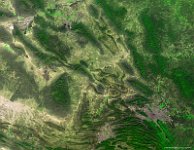
22/03/2016, Mina, Mexico The 100 m false-colour image of 22 March 2016 shows us Mina, a town located at the northwestern part of the northeastern Mexican state of Nuevo León. Nuevo León has an extreme climate, and there is very little rainfall throughout the year. The territory covers 64,220 square kilometres, and can be divided into three regions: a hot, dry region in the north, a temperate region in the mountains, and a semi-arid region in the south. The Sierra Madre Oriental mountain range affects in an important way the lay of the land forming the Galeana and Doctor Arroyo plateaus, the Iguana, Picachos, Papagayos, and Santa Clara mountain ranges, and the Pilón, Ascensión, and Río Blanco valleys. The flora of the region includes brush and pastures in the low regions, and pine and oak trees in the mountains. The fauna includes black bears, mountain lions, javelinas, prairie dogs, foxes, coyotes, and white-tailed deer, along with smaller species. |
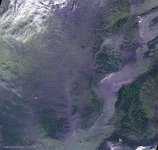
13/01/2015, Smog Zhongtiao mountains, China The 100 m false-colour image of 13 January 2015 shows us a view of the Zhongtiao Mountains, a major mountain range located in the south of China’s Shanxi Province, covered with smog. Smog is unhealthy to humans and animals. Smog is common in big cities with a lot of industry and traffic. Cities located in basins surrounded by mountains may have smog problems because the smog is trapped in the valley and cannot be carried away by wind. |
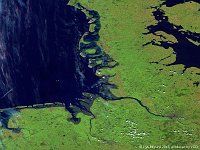
22/08/2015, Wadden Sea, Denmark The 100 m false-colour image of 22 August 2015 shows us a nice view of the Wadden Sea in Denmark and northern Germany. The wadden region is relatively young. It only formed during the post-glacial period, around 7000 years ago. Although even now sandbanks and dunes are still forming and eroding in a rapid tempo. The dynamics of the area are unique. You still find landscapes in all phases of development. Even today with your own eyes, you can see and experience how landscapes were created in the glacial period. Deposited sediment is visible by the greenish colours in the river's mouth, while the estuarine wetlands are indicated by the green-grey areas. |
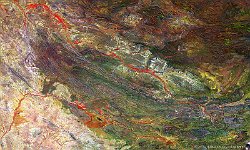
08/07/2015, Barlee Range, Australia The Barlee Range in Western Australia, known for deep gorges and an extensive network of springs, pools and waterfalls, banded sedimentary formations and also home to a Nature Reserve. With this fascinating 100 m image, we are pleased to announce that MultiTemp 2017 will be organised in Bruges, Belgium from 27-29 June 2017. |
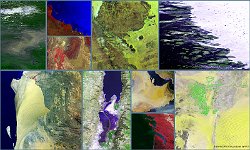
04/10/2016, World Space Week Following its declaration by the United Nations in 1999, World Space Week has continued to annually celebrate the benefits of space and space exploration for mankind. This year’s theme is ‘Remote Sensing: Enabling our future’ and puts the spotlight to Earth Observation space missions such as PROBA-V. World Space Week inspires the organization of events around the world and brings space and society closer together. This collage of PROBA-V images at 100 m and 300 m resolution show Mother Earth in all its glory. Together with the indispensable SPOT-VEGETATION time series, PROBA-V facilitates users to exploit nearly 18 years of global vegetation data for different applications: from global environmental and agricultural monitoring to coastal and inland water applications. |
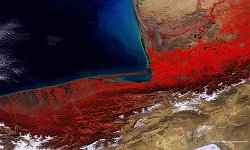
08/03/2016, Caspian Sea, Iran-Turkmenistan PROBA-V observations are increasingly used for water quality applications, such as information on chlorophyll concentration and water-suspended materials. The 100 m false-colour image of 8 March 2016 shows a potential application, with high Atrak river sediment concentrations that can be recognised by light-blue taints along the south-eastern Caspian coast. Further, the lower image part shows snow-covered peaks from the Alborz mountain range, while in the lower-right corner the Haj Aligholi Salt Lake is partly visible in white. |
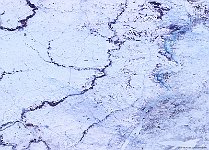
23/01/2015, Tree walls, Russia This image shows the snow-covered environment of Penza, Russia, a city with about 500,000 inhabitants located 600 km southeast of Moscow. In the image, some parallel thin lines are visible from the lower toward the upper central part. These lines represent former Soviet forest protective plantings, of which several were built during 1950s and 60s. |

27/02/2016, Everglades, Florida This colourful daily synthesis image, captured by PROBA-V at the end of February 2016, extends from Whitewater Bay, the dark body of water in the west to the long stretch of islands just above sealevel – the Florida Keys – in the southeast. |
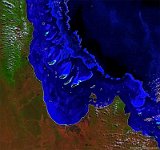
08/07/2015, Great Barrier Reef, Australia The 100 m image of 8 July 2015 shows Great Barrier Reef’s northern part, recognisable by the light-blue taints, while deeper parts of the Pacific Ocean appear dark-blue. In the lower central part of the image, the North Kennedy River emptying into Princess Charlotte Bay is visible. |

08/12/2015, Kizilsu, China Kizilsu is an autonomous prefecture in the Chinese Xinjiang region. It has an area of about 69,000 km2 and its terrain is mainly mountainous. The climate is typical continental, with cold winters and warm to hot summers.The 100 m image shows the various mountain ranges and valleys, with the Xiao’ Er-Kule (a saline lake) visible on the left. |
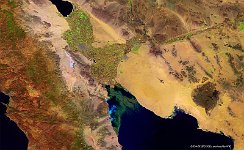
29/09/2015, Gulf of California, Mexico The false-colour image of 29 September 2015 shows the northern Gulf of California. The greenish and blueish colours in the centre indicate sediments and alga blooms. Further, the Sanora Desert is visible by the yellow-brown colours, while the dark-brown colours in the left part indicate mountains of the Peninsular Range. |
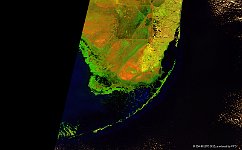
25/01/2015, Pumpkin Key, Florida This is a 100 m image of Pumpkin Key, a private island in the Florida Keys. The Florida Keys have no analogue in the continental U.S. Geographically they are utterly unique—a chain of small, semi-tropical islands arching 100 miles from Miami to Key West connected by a series of bridges along US 1. For avid fishers and divers, there may be no place like it anywhere. |
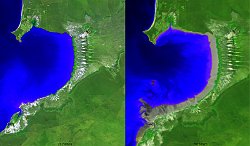
06/2015, Broome, Western Australia The large tidal range is illustrated by the images above. The left panel shows a 100 m image taken at 16 June 2015 near high tide (+8.8 m), while the right panel presents a 100 m image taken at 25 June 2015 near low tide (+3.7 m). The difference in water level between the two images is approximately 5 m, resulting in about 5 km of beach emerging at low tide. |
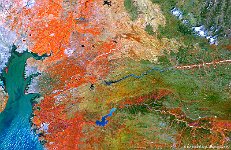
26/04/2015, Surat, India The 100 m false-colour image of 26 April 2015 shows part of north-western India. Prominent features are the Gulf of Khambat (left part) and the Narmada and Tapti Rivers (centre and lower part, respectively). At the mouth of the Narmada River, the city of Surat is visible by the grey area. Further, the green-brown area in the image centre indicates the Shoolpaneshwar Wildlife Sanctuary. |
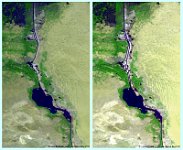
18/07/2015, Egypt, new Suez Canal On 6 August 2015, a second Suez Canal was opened by Egyptian Prime Minister Abdel Fattah al-Sisi. The 70 km long canal was dredged by international consortiums, with contributions from the Belgian companies Jan De Nul Group and DEME and was completed in only one year. The figure above shows PROBA-V 100 m images of the original Suez canal (2 July 2014, top view) and the newly dredged second canal (18 July 2015, bottom view). |
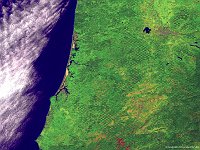
10/06/2015, Roseburg, Oregon, USA The 100 m image of 10 June 2015 shows the various checkerboard patterns throughout the state of Oregon. In the upper part of the image, the city of Eugene with the Fern Ridge Lake just west of it are visible. Finally, from the lower part to the middle-left part of the image the Umpqua River can be seen. |
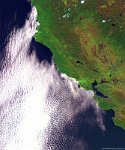
17/04/2015, Clouds, Californian Coast The 100 m image of 17 April 2015 shows a stratocumulus field, recognisable by the cellular and wave-like structures, off the Californian coast near the cities of San Francisco and San Jose. In the lower-right corner of the image, San Francisco Bay is visible, while the upper part shows Mendocino National Park. |
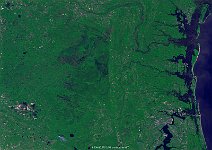
10/12/2014, Okefenokee, Florida The 100 m image of 10 december 2014 shows the Okefenokee Swamp by the dark green area in the middle part. To the east, various Atlantic coastal barrier islands are visible. The patched bright area in the lower-left corner indicates an extensive phosphate mining area, while the lower-right corner shows the outskirts of Jacksonville city. |
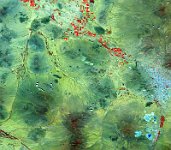
17/05/2015, USA, Tohono O'Odham Nation Reservation The Tohono O'Odham Nation Reservation is located in Arizona, United States. The reservation is the homeland of the Tohono O'Odham ('Desert People'). |
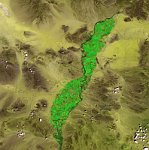
16/5/2015, USA, Colorado River Reservation The Colorado River Indian Reservation is a native American reservation in the southwest of the United States, at the border of Arizona and California. The Reservation was established in 1865 and has an area of about 1,100 square kilometres. The reservation's economy is mainly driven by agriculture and recreation. The 100 m image of 16 May 2015 shows the Reservation within the desert area. The irrigated agricultural areas are visible by the green rectangular patches. |

26/10/2014, United States, Cape Canaveral Cape Canaveral is located at the eastern Florida coast. It is most known for the Cape Canaveral Air Force Station, from which almost all NASA spacecrafts are launched. The 100 m image shows the city of Cape Canaveral in the middle-left and Kennedy Space Center located at the bow-shaped cape at the coast. Further, the typical Florida lakes and wetlands are visible. |
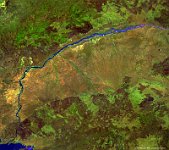
29/10/2014, Zimbabwe, Mana Pools Mana Pools is a wildlife conservation area in the northern part of Zimbabwe designated as UNESCO World Heritage Site. The area consists of lakes in the lower Zambezi region that recur each year after the wet season. The area contains Zimbabwe's largest concentration of hippopotamuses and crocodiles. The 100 m image of 29 October 2014 shows the Mana Pools region at the beginning of the wet season. |
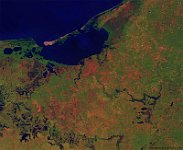
01/02/2015, Mexico, Laguna de Terminos Laguna de Terminos is the largest tidal lagoon located on the east coast of Mexico. About 30% of the lagoon is covered with seagrass and was designated as a federally protected area by the Mexican government in 1994. The 100 m image of 1 February 2015 shows the lagoon in its entirity. In the lower-left part of the image, the meandering Rio Grijalva is visible. |

25/12/2014, Murray-Sunset National Park, Australia The 100 m image of 25 December 2014 shows the Murray-Sunset National park surrounded by extensive wheat, barley, and oat fields. North of these fields, the Murray River and lake Victoria are visible. Also note the distinct state boundary between Victoria and South Australia. |
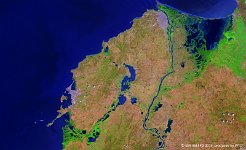
08/03/2015, Colombia, Ciénaga Grande de Santa Marta The Ciénaga Grande de Santa Marta is the largest of the swampy marshes located in Colombia between the Magdalena River and the Sierra Nevada de Santa Marta. It has an area of 4280 km2 , belongs to the outer delta system of the Madgalena River, and is separated from the Caribbean Sea by a narrow, sandy artificial spit built in the 1950s. The marsh's large lagoon is connected to the Caribbean Sea via a narrow strait (the La Barra channel) located between the town of Pueblo Viejo and the city of Ciénaga. |

01/03/2015, solar eclipse, Europe On 20 March 2015, a total solar eclipse was experienced in a narrow band from the Faroe Islands through Svalbard. Europe and North-Africa experienced a partial eclipse, with the solar disk obscured for 40 – 90%. This partial solar eclipse was also observed by PROBA-V, of which 300 m images of 1 March (left) and 20 March (right) are shown. In comparison to 1 March, the partial darkening on 20 March is well visible. Although over northern Africa virtually no darkening occurs, the shadow casted by the eclipse is well visible over Italy, the Alps, and Central Europe, with the largest darkening over the western part, which is closest to the total eclipse band. |
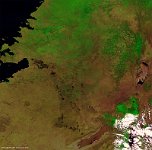
29/06/2014, Serengeti, Tanzania One of the most famous areas with many beautiful and varied forms of flora and fauna is the Serengeti National Park in Tanzania. This park is home to among others 1.5 million migrating white bearded wildebeest, about 250,000 zebras, as well as numerous Nile crocodiles. Its name derives from the Maasai area description of "place where the land runs on forever". |

16/08/2014, Egypt, Suez Canal The Suez Canal is a 163 km long waterway that connects the Mediterranean Sea and the Red Sea. The canal construction started in 1859 and it took 10 years until completion. After the completion, ship traffic to Asia was reduced by about 7,000 km. This 100 m image shows the southern part of the canal, with the city of Suez at the bottom of the image. Further, the Great Bitter Lake north of Suez is visible, as well as pivot irrigation fields northwest of the Lake. |
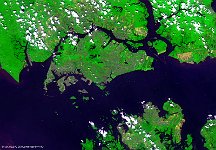
24/10/2014, Singapore This PROBA-V 100 m image highlights the city-state of Singapore. With an area of approximately 683 km², Singapore is the smallest country in South-East Asia. |
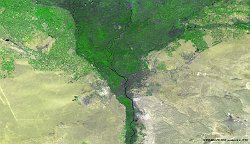
05/10/2014, Cairo, Egypt This PROBA-V 100 m image of 5 October 2014 beautifully shows the metropolitan area of Cairo (more than 16 million inhabitants) surrounded by the desert areas and the Nile Delta. The city and recent urban extensions to the west and east show up in the middle part of the image. To the northwest and northeast, large areas of irrigated land are visible, while in the southeast the mountainous desert and some wadis can be seen. The Nile Delta, with a total area of about 25,000 km², is one of the most densely populated agricultural areas in the world, with 1,360 inhabitants per km². On the fertile soils, many crops like cotton, rice, and sugar cane are grown. |
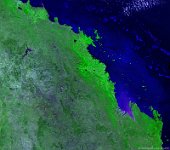
30/06/2014, Great Barrier Reef, Australia The Great Barrier Reef is the world's largest coral reef system composed of over 2,900 individual reefs and 900 islands covering 2,300 kilometres over an area of approximately 344,400 km². The reef is located in the Coral Sea off the coast of Queensland, Australia. |
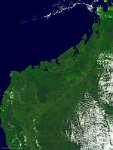
18/06/2014, Bombetoka Bay, Madagascar Bombetoka Bay, shown here on a 100 m image of 18 June 2014, is a bay on the northwestern coast of Madagascar near the city of Mahajanga, where the Betsiboka River flows into the Mozambique Channel. Numerous islands and sandbars have formed in the estuary from the large amount of sediment carried in by the Betsiboka River and have been shaped by the flow of the river and the tidal forces. |
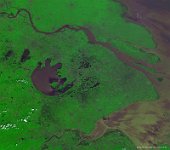
01/05/2014, Yangtze River Delta, Shangai Shanghai is the largest city proper in the world, with more than 24 million inhabitants as per end 2013 (source: China Daily). It is one of the four direct-controlled municipalities and is a global financial center and a transport hub with the world's busiest container port. Shanghai is located at the Yangtze River Delta in East China, at the river's estuary, as shown at this 100 m image of 1 May 2014. |
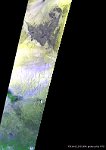
04/04/2014, Chad, Africa Chad, officially the Republic of Chad, is a landlocked country in Central Africa. It is bordered by Libya to the north, Sudan to the east, the Central African Republic to the south, Cameroon and Nigeria to the southwest and Niger to the west. It is the fifth largest country in Africa in terms of area. |

01/04/2014, National Forest, Colorado This 300 m image of 1 April 2014 shows parts of Utah (left) and Colorado (right). In the upper left, the Great Salt Lake and Lake Utah are visible. The Great Salt Lake has a salinity of 5-27%, being the fifth saltiest lake in the world. |
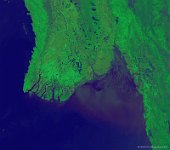
04/03/2014, Gulf of Marbatan, Burma The Gulf of Martaban is a part of the Andaman Sea in the southern part of Burma. The gulf is named after the port city of Mottama (formerly known as Martaban). The Salween Sittaung and Yangon rivers flow into it. A characteristic feature of the Gulf of Martaban is that it has a tide-dominated coastline. Tides range between 4–7 m, with the highest tidal range at Elephant Point in the western Gulf of Martaban. During spring tide, when the tidal range is around 6.6 m, the turbid zone covers an area of more than 45,000 km², making it one of the largest perennially turbid zones of the world's oceans. During neap tide (the lowest level of high tide), with a tidal range of 2.98 m, the highly turbid zone coverage drops to 15,000 km². The edge of the highly turbid zone migrates back-and-forth in-sync with every tidal cycle by nearly 150 km. This 300 m image of 4 March 2014 shows the Gulf of Martaban and the various rivers flowing into it. The light-brown haze in the Gulf indicates increased phytoplankton concentrations. |
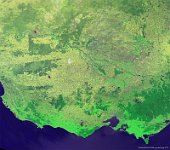
14/01/2014, South Australia A 300 m image taken at 14 January 2014, showing the southern part of Victoria (Australia). The city of Melbourne is located at Port Phillip in the lowermost part of the image, east of Melbourne the Yarra Ranges and Alpine National Parks can be seen by the dark green colors. |
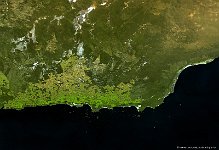
08/10/2013, Agriculture, SW Australia Two capes are clearly visible on this 300 image of 8 October 2013: Cape Le Grand National Park in the middle and Cape Arid National Park to the right. Australia is a major agricultural producer and exporter. Agriculture and its closely related sectors earn $155 billion per year or a 12% share of the GDP. Australian farmers and graziers own about 136,000 farms, covering 61% of Australia’s landmass. |
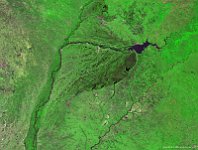
07/10/2013, Iberá Wetlands, Argentina The Iberá Wetlands are a mix of swamps, bogs, stagnant lakes, lagoons, natural slough and courses of water in the center and center-north of the Corrientes province, Argentina. Iberá is one of the most important fresh water reservoirs on the South American continent and is the second-largest wetland in the world after Pantanal in Brazil, having a total area of 15,000–20,000 km². |
